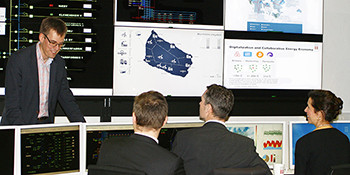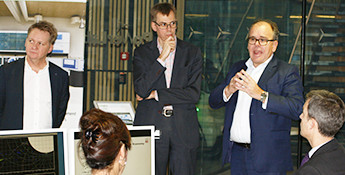The Vice-ambassador of the American Embassy in Copenhagen,
Laura Lochman, visited PowerLabDK with a small delegation this week to hear more about our EcoGrid project on Bornholm and other energy activities that Center for Electric Power and Energy (CEE) are facilitating. CEO Henrik Bodskov at IBM Denmark and Head of Energy & Utilities, IBM Nordics, Nils Overgaard were also present, representing one of the largest collaborations between CEE and American companies regarding new energy solutions.
Vice-ambassador Laura Lochman has previously visited the island of Bornholm to learn about the EcoGrid project where more than 1000 households participate in an experiment on regulated electricity use. As one of the main facilitators of this project, Vice-ambassador Lochman was interested in hearing more about CEE’s involvement in the project and also how American-based companies like IBM contribute to the development.
Close collaborations
Vice-ambassador Lochman is fascinated by the way Denmark continues to be a pioneer within the field of sustainable energy and especially when it comes to integration and penetration of renewables in the energy system. Head of Center at CEE, Professor Jacob Østergaard, explains that it has a lot to do with the close collaboration between universities and industry.
"A very advanced algorithm developed between IBM and DTU regulates the households"
Professor Jacob Østergaard
“Denmark is a pioneer in the area. We have high penetration in the system and we are quite ambitious on the matter which also has made us number one in Europe when it comes to export of energy technology. The reason for this is partly due to the short geographical distances between industry, universities, authority and energy companies which insure close integration. This in particular makes us an eco-system with a capability to develop new solutions to the benefit of all the stakeholders - something quite unique and a reason we cherish working with companies like IBM.” Jacob says.
Disruption is the new black
Everybody is talking about disruption these days and it was also mentioned during the embassy visit, as CEE work to keep abreast regarding energy solutions. In this way CEE projects can serve as a disruption on established companies for whom the new technology won’t be mature enough to cover their customers’ extensive needs. That is also a reason why collaboration between researchers and companies are vital in the course of development. “Disruption are approaching at a high speed and things are developing very fast in the energy field which is why IBM wants to work with leading researchers and engineers to conduct utmost advanced technology” Nils Overgaard, Head of Energy & Utilities at IBM, explains. The close collaborations are in this way expected to set new patterns and define new technologies which will be part of the dramatic changes in the industry going forward.
Digitalization
CEE’s main objective is to establish the most integrated, most market-based and most flexible energy system in Europe. For this it is essential to include digitalization in your research and design. “A lot of new solutions come into play where we use digitalization to optimize the system to operate more intelligent – which is where cooperation with IBM becomes important” Jacob Østergaard says. A very advanced algorithm developed between IBM and DTU are running in the homes of the EcoGrid participators regulating the power consumption and storage for each household which secures cheaper electricity than the average price.
Transferability
Though Vice-ambassador Lochman is impressed with the success of the project and means of collaboration, she is still curious about how the solutions can be transferred to other societies. “So the interesting question would be how transferable it would be to parts of the United States for example where there is a different culture, philosophy and so on”, she asks. Jacob Østergaard refers to a recent study that shows how two very different groups of people still are a part of the project for the same reasons. He explains:
“Actually the project at Bornholm and a newer project at Nordhavn show two very different test groups – almost opposites. We went into the demonstration thinking that the main motivation for participation would be to save money on the electricity bill, but actually it was far more social elements that motivated the customers. Elements like knowledge about their energy use, using green electricity and being part of a community was top of the list of why residents chose to take part in the demonstration.” The motivation for participation indicates therefore to be the same even though culture and philosophies might be different, which makes a fine opening for the possibly of transferring the solutions to other societies.
No doubt there are many challenges developing sustainable energy systems, however communication and partnering between different industrial and political stakeholders takes us the first step of the way.


On the left: Professor Jacob Østergaard talks about CEE energy activities. On the right: CEO and Head of Energy & Utilities at IBM Denmark explains their part in the EcoGrid project
To learn more about the EcoGrid project pleace visit the project website. We also velcome you to explore the PowerLabDK facilities at our website here.